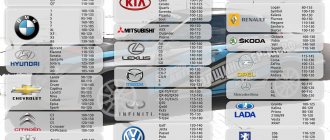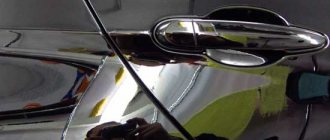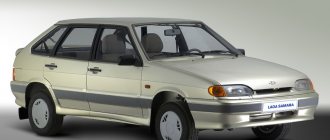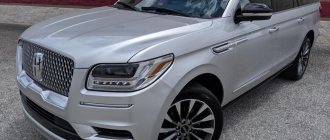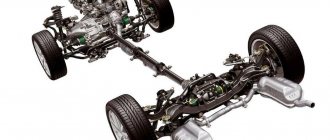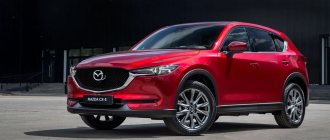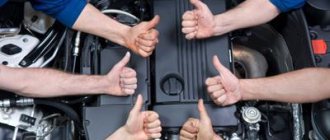Every car owner knows that one of the important stages of restoration work is the choice of paint color. In modern times, the most popular colors for car painting are metallic or pearlescent. There are many tones of this enamel. And with the help of metallic car paint, familiar colors such as blue, sulfur or gray change their appearance, acquiring a silver tint.
Car paint composition
But choosing these attractive and stylish shades requires a thorough approach. If the selection is incorrect, the areas that have been repaired will differ in shade from the rest of the body. Therefore, to avoid such a situation, you need to carefully approach the issue of choosing paint for your car.
Car paint not only helps to create the style of a car, but is also a reliable coating that will protect the surface from rust and mechanical damage.
Car paint consists of the following main components:
- a solvent that helps obtain the required consistency and viscosity;
- pigment that determines the color and shade of paint;
- binders - necessary for uniform application and imparting a glossy shine.
Depending on the combination of components, different types of paint are distinguished, which have certain properties and characteristics.
Applying a base coat of paint
According to the metallic painting technology, it involves applying auto enamel in 2-3 layers. In this case, the first layer (the so-called base) should be applied in a thicker layer, but at the same time try to prevent smudges. The second layer is applied from a greater distance and should be thinner than the base.
To apply the base correctly, it is advisable to have experience working with a spray gun so that spots or streaks do not appear on the parts during painting. Therefore, we recommend that you first apply a small layer of base to achieve a uniform layer, then finish applying the layer to the desired thickness the first time. Then you need to apply another 1-2 even layers.
When applying auto enamel, you should take into account certain settings of the paint gun (certain pressure, paint supply) at all stages of painting the car. For the base, it is best to use a paint spray nozzle with a diameter of 1.2-1.3 mm.
When painting, you must also take into account the direction of painting: large parts - continuously from one edge to the other, and not from the edges to the center, vertical parts - from bottom to top.
Metallic car paint: composition and main parameters
There are a huge number of types of paint, among which metallic car paint is becoming increasingly popular. It can visually give a silvery tint to any color.
Car paint has a special effect, which is achieved through the introduction of special pigments of zinc, brass, copper, bronze or aluminum. Light hitting the surface is reflected from these particles, resulting in a shiny surface.
The amount of these pigments in the paint, the correctness of the shape and the proximity of their location to each other will determine the degree of sparkle of the car’s surface. The silver tint is obtained as a result of the introduction of special flat particles into the paint composition, the reflective ability of which directly depends on the angle of location.
Metallic car paints allow you to create a unique style for your car. It helps to obtain a beautiful metallic shine of the body, which will make the car spectacular, stylish and stand out from other cars.
Differences between metallic and other types of paints
The main differences between metallic paint and conventional paints are as follows:
The composition contains aluminum powder, thanks to which the material acquires shine. It is much easier to paint the surface with regular enamel. But metallic needs to be applied perfectly evenly, because otherwise unsightly spots cannot be avoided. Metallic is characterized by higher resistance to corrosion processes, which is explained by the presence of aluminum in its composition. Regular paint is more prone to fading. Metallic prevents the interior from heating up to a greater extent in hot weather (higher light reflection). Metallic looks more attractive. The cost of metallic paints is noticeably higher compared to conventional paintwork materials.
Color options
Painting a car in metallic color is carried out taking into account certain features. Thus, it is necessary to monitor not only the uniformity of distribution or quality of coloring, but also the thickness and number of layers. There are several material options:
- single-layer metallic – this type contains varnish, but the painting can be spoiled by the appearance of smudges or bubbles;
- two-layer – painting occurs in two stages with an interval for the first layer to dry, resulting in a shiny coating that is resistant to mechanical stress and damage;
- three-layer metallic - the result of this option is a pearlescent sheen.
The most common method for painting a car is the two-layer method. Whereas technically complex is a three-layer coating intended for non-standard painting options.
Metallic car painting materials
All that remains is a small matter: your desire to do and learn. What you want to do depends on you, but we will tell you the theoretical part of how to paint a car metallic.
Painting a car with your own hands, whether metallic or matte, is difficult and at the same time not. The technology of painting a car with a metallic paint is not much different from the technology of painting a car in general. In principle, the technology, materials and equipment for complete painting or local painting of the body after repairing chips or cracks are no different.
Metallic car painting technology differs from standard painting in that it has a two-layer base. Coating with base and varnish.
Basic basis (in car painter slang, simply “base”). The base is a nitro-based paint. In essence, it gives color and a metallic effect. The base has no shine and is not weatherproof. Drying time between base coats is usually 15-20 minutes. Very important! The base application temperature should be about 20 degrees. If the temperature is 5-10 degrees lower, the drying time will increase and the quality of the base will deteriorate.
Varnish . Made on acrylic base. The second in line, but first in importance, element of metallic car painting. The varnish performs the protective function of the paintwork of the body. There are and are used two types of varnish for metallic painting.
Varnish type MS . This varnish is considered a soft varnish. It requires application in 3 layers. It is good in that it is easy to polish the body, but as a disadvantage it is less economical for work and less durable.
Varnish type NS . This is a hard type of varnish. Only 1.5 layers of application are required. Slightly the first, and thoroughly the second. Gives less smudges when painting. Durable but difficult to polish.
Metallic car painting is done using traditional materials and equipment: putty, primer, spray gun, etc. All this remains the painter’s unchanged tools.
The technology for painting a car with metallic paint is completely identical to the technology for painting a car in standard colors. And it also includes: preparing the car for painting, priming, putty, preparing the area for painting and painting. Polishing the body after painting is a mandatory procedure. Do not forget that the process takes place in artisanal conditions and there will definitely be dust and dirt.
Metallic paint shades
Every year, the palette of metallic shades becomes more diverse, and standard car colors such as silver, black or blue are complemented by new unexpected shades, which include orange or pink.
The factory palettes of car factories are updated annually, and each manufacturer strives to interest potential buyers with originality and even creativity. So, in the brochure of Lada cars, black metallic is called “space”, and silver is called “snow queen”. But most often, manufacturers prefer to use ready-made materials from paint coating suppliers, repeating their color palette.
It happens that the presented color palette does not have the required shade. Then you can adjust the color by mixing materials that are identical in composition, but different in tone:
- an orange tint can be obtained by combining yellow with red;
- to get dark blue, you should add black and a little green to the main shade;
- Recently fashionable is a purple tint, which can be obtained by adding red to blue;
- green, red and blue colors will ultimately give a purple tint - a rather non-standard car color;
- Even a silver shade can be combined independently - to do this you need to add blue and black to white.
The only color that cannot be mixed is black. You can mix blue, brown, green, yellow and other colors to make black, but the shades will always be different colors.
Paint thinners
In offset machines, the inking apparatus consists of many rollers, and the ink remains in the machine for quite a long time. If it contained highly volatile solvents, then, when drying, it would have time to change its properties many times during printing, which should not happen under any circumstances. Therefore, offset inks use low-volatile thinners with a very high (up to 300 degrees and above) boiling point - mineral oils (see Table 2).
Table 2. Boiling range of thinners for offset inks (in degrees Celsius)
| Hit set for paints | 240-290 |
| For sheetfed offset printing inks | 280-310 |
| For cold set paints | 280-370 |
The amount of thinner in paste offset paints usually does not exceed 30%. But liquid inks for gravure and flexo printing contain a lot - more than 65% - of solvent.
Only diacetone alcohol, which is no longer used in the production of paints, was classified as high-boiling alcohol (boiling point 166 degrees Celsius).
Table 3. Volatility of some solvents for flexographic and gravure printing.
| Solvent | Boiling point | Evaporation number |
| Ethanol | 78 | 8,3 |
| Methyl ethyl ketone | 80 | 2,6 |
| Isopropanol | 82 | 1,0 |
| Isopropyl acetate | 88 | 4,0 |
| Ethoxypropanol | 134 | 33,0 |
| Ethyl acetate | 77 | 2,9 |
| Water | 100 | approx.90.0 |
It is not customary to say anything specific about the chemical composition of paints and, especially, about new formulations and technologies, since manufacturers keep this information secret from each other.
Composition of metallic paints
In order for the painted surface to have a metallic sheen, leafing and non-leafing particles are simultaneously added to the composition. In other words, we can say that such mixtures use components with floating and non-floating pigments. The first include small and flat particles, which can be from:
- copper,
- gold,
- silver,
- an alloy of copper and zinc.
Pigments that do not float, in turn, can be from:
- aluminum,
- shiny plastic
- mica.
Initially, the main source of decorative pigments was aluminum, but this material has a significant drawback. The metal should be protected from exposure to the atmosphere. Despite this, aluminum helps make an excellent decorative surface.
Using the base of this material, pigments with different characteristics can be produced. Using stearic acid for aluminum, in a short time you get particles that will not float and stick to each other. But it should be borne in mind that such pigments are not used together with film-forming substances. Aluminum components may float to the surface of the paint if it contains a film former. The formed continuous metal layer will consist of small grains ranging in size from 5 to 15 microns.
Powder paints have some disadvantages if their base consists of pigments that float. Surfaces treated with this composition are short-lived and scratches easily form on them. The paint is not resistant to exposure to the atmosphere and deteriorates after the use of certain substances.
Experts came to the conclusion that after several days spent in a humid environment, the coating begins to deteriorate.
Sometimes, to obtain non-floating pigments in the production of paints, oleic acid is used, which interacts well with substances that help form a film. The particles of such paints are larger in size than the same aluminum pigments; they do not float and can be evenly distributed throughout the entire volume of paint.
Due to the fact that the orientation is not parallel, such compositions have a distinctive feature: after drying, small sparkles are visible on the surface. High protective properties of the coating are ensured due to the uniform distribution of particles. As a result, the pigment oxidizes more slowly and high resistance to weathering is achieved; such coatings are less susceptible to destruction in a humid environment.
Body preparation
Before starting paint and varnish work, it is necessary to carry out certain preparation of all body elements. In particular, it is necessary to putty and then apply a primer. Do not forget that the putty must be the same color as the future coating of the car. Also important aspects of preparation include degreasing and blowing off the body. That is, you first need to blow off the body, and then, using two napkins, begin degreasing.
One napkin is designed to wipe the body with an anti-silicone compound. The other, accordingly, is used to remove moisture from the surface of the body. After this, the blowing operation is repeated. At this point, the initial stage is over, and you can proceed to the actual work of painting the body.
Preparing for painting
Preparing the surface for applying metallic paint is practically no different from preparing it for painting with acrylic or alkyd two-component enamel, but still has its own nuances and features.
Defects from a poorly prepared surface on such colors are noticeable many times more than on dark ones (chips, unevenness, scratches, dark debris, etc.).
- The soil treatment should be completed with P-600 abrasive on an eccentric machine, preferably with a stroke of 3 mm, if you are working dry.
- When working on wet soil, the primer should be finished with P-800 abrasive, or better yet P-1000. When rubbing by hand.
- There should be no defects on the surface (chips, large marks, scratches) for a high-quality result.
- Thoroughly blow and dust off the area to be painted.
- Degrease. High-quality degreasing is the key to a good result. Use a special anti-silicone (degreaser).
- Before painting, go over with a tack cloth. To remove remaining debris and dust.
- Strain through a filter funnel.
Read more: Imax b6 charging a car battery
Metallic paint is diluted with a special solvent for base paints. You can also use any branded acrylic thinner. Diluted according to the standard 50-60% thinner. You can also increase or decrease this value at your discretion.



